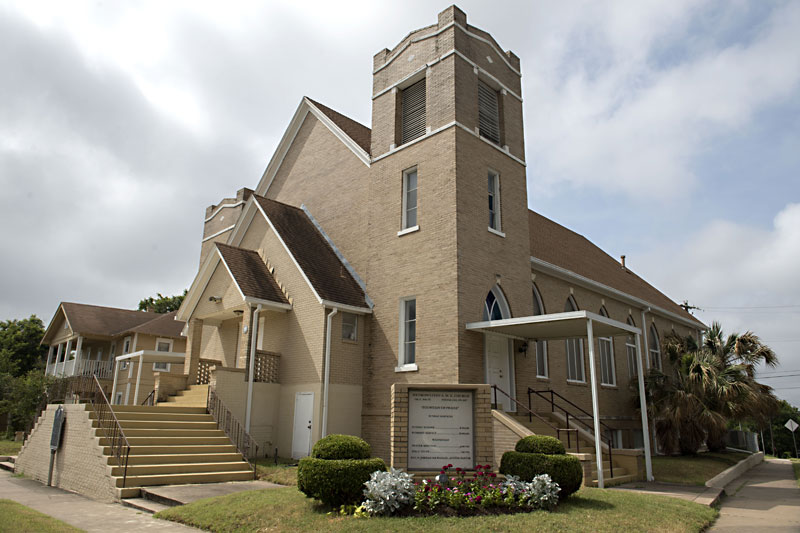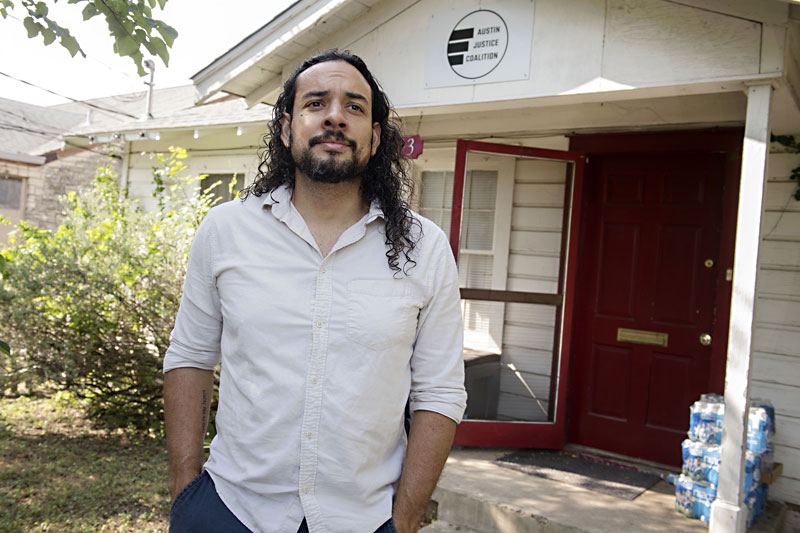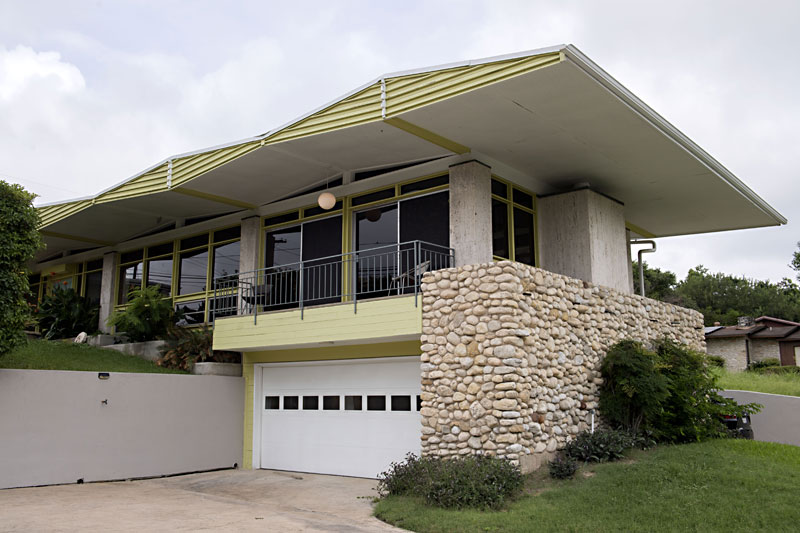With Equity in Mind, Austin Embarks on Bringing Its History Up to Date
So many more stories to tell
By Clara Ence Morse, Fri., July 2, 2021
In 1895, a wealthy cotton trader named Daniel H. Caswell found his way to Austin from Tennessee. Five years later, he built himself a grand house at the corner of West Avenue and 15th Street, at the edge of Austin's original city limits, laid down in 1839. Four years after that, his son William had another grand house built for himself on the other side of 15th Street. Seventy years later, both Caswell Houses earned a much-desired listing on the National Register of Historic Places.
An old website proposing an Austin historic district in that neighborhood notes that the William T. Caswell House is a Classical Revival home built of rusticated ashlar limestone and featuring "large trabeated windows." It now serves as a law office; Daniel Caswell's home is a popular wedding venue, which also houses the Austin Junior Forum, a women's volunteer organization known for its "Christmas at Caswell House" fete.
A mile east, another building on the National Register has a much different story. The Historic Victory Grill – that's its formal name – is built mostly of cinder blocks, with a square build that is "nothing extraordinary," according to its unofficial website. It's an example of vernacular architecture, "meaning literally no professional assisted in its design," the website notes, when Johnny Holmes built the initial structure in 1945. Like the rest of the original East End Black business district, it has faced challenges throughout its years, including a fire in 1988 that nearly destroyed it. Now, most of the Grill's neighbors on East 11th Street either are new, have been carefully restored with public funds, or have been gentrified.
The Grill is called "Historic" for a different reason – it holds an iconic place in Austin's culture. It began as a gathering place for Black World War II veterans (hence "Victory"); then emerged as the city's first real live music venue; then became one of the hottest, and eventually one of the last, juke joints on the legendary Chitlin' Circuit that sustained Black performers for decades. That's the legacy that got it elevated to the National Register in 1998.

The juxtaposition of these landmarks is one the city wants to bring into the foreground as it embarks on its first comprehensive historic preservation plan since 1981. Members of the working group that will do much of the heavy lifting and community listening in that effort were appointed last week. Their project, as Cara Bertron of the city's Housing and Planning Department describes it, has a deceptively simple goal. A "really effective" preservation plan can benefit the community by making it continue to feel like a "real place" – something which Bertron said appeals to both longtime residents and potential newcomers.
"There are lots of things that make a city feel like a real place. They could be buildings and streetscapes, the way you feel when you walk through a neighborhood or down a commercial district," Bertron said. "Historic preservation plays a role in articulating what the elements of place are, and also the community heritage and the community history that has led to the place feeling like it does."
Various Kinds of Riches
Without a functional preservation plan, the way those "elements of place" have been defined and protected in Austin has largely been ad hoc. The primary tool for historic preservation is a system of tax breaks for property owners, intended as compensation for the expense of maintaining their pieces of Austin's past. It has been evolving for close to 50 years – nearly long enough to be considered "historic" itself. Structurally, this system has privileged the city's Caswell Houses over its Victory Grills.
The owners of marquee properties in affluent neighborhoods, including many newcomers to the Eastside, can afford to keep up with the burdensome paperwork to apply annually for historic tax exemptions or hire expensive consultants to build a case for historic zoning from arcane architectural details or associations with ancient Austinites. Increasingly, so can their neighbors, who may try to stop teardowns or infill projects by prompting the city to initiate historic zoning against the owner's wishes – one of few circumstances where Texas law allows this.
Meanwhile, the owners of structures like the Victory Grill, which still belongs to the Holmes family, cannot pay their bills with the warm feelings Austinites hold toward their cultural importance, as the cost of the dirt they sit on rockets into space. Access to preservation has lagged behind in these neighborhoods, harming families. Only in the last 20 years have preservation experts, planners, and advocates even begun to figure out what is historic, how to protect it, and how to leverage those assets to help the people who made that history stay in their neighborhoods.
João Paolo M. Connolly, Austin Justice Coalition's director of housing and community development, is one of those advocates. He told us that preservation has "historically served the agenda of helping to preserve the exclusionary character of more affluent white neighborhoods, and also helping to provide tax breaks and a whole number of other benefits to wealthy property owners in the whiter parts" – including the gentrifying Eastside – "of this very segregated city."
As Austin's affordability crisis verges on a catastrophe, its elements of place will become harder and harder to maintain intact. The median sales price for a home in the city of Austin is now $565,500, having grown by more than a third – nearly $200,000 – in the last 12 months (see this week's "Austin at Large"). The city currently designates just 0.7% of its parcels as historic – six times below the national average – but has long given them more generous tax exemptions than do other Texas cities. Only in recent years has the city codified local historic districts as a tool to preserve elements of place without such big windfalls to individual owners.
A Broader Conversation

Though the process of creating historic districts, or protecting historic properties, remains both laborious and politically fraught, it's been on the uptick in recent years, raising concerns about how preservation might limit needed new housing development or even contribute to displacement. "The one big fear a lot of folks have, especially in a city that is experiencing a housing crisis, is that historic preservation is weaponized and used as a mechanism to stop development," said Greg Anderson, the director of community affairs for Austin Habitat for Humanity and an outspoken former member of the city's Planning Commission.
How does one preserve heritage and history in a city changing as rapidly as Austin is? Does protecting existing buildings in some neighborhoods contribute to faster turnover, lower affordability, and more displacement in other areas of town? How should the city balance protecting its architectural assets with honoring and sustaining a cultural legacy that is both "historic" and still alive today? That's what makes the new preservation plan such a gargantuan project.
And to make sure it reflects the views and provides opportunities for all of Austin, the 30-member working group is an essential element. The city received 150 applications from 42 ZIP codes to join the group; Bertron said the city used all the resources at its disposal to be able to reach people, including offering a stipend to committee members ($25 per hour) for participation, partnering with community organizations, sending emails, and posting fliers in libraries and coffee shops.
As a result, while the working group isn't a representative random sample of all Austinites, it's quite a bit more diverse than is often the case with such projects. 36% of appointees are white (compared to 48% of Austinites), 31% are Latinx (34% of Austinites), 3% are Asian American, Native Hawaiian, or Pacific Islander (8% of Austinites), and 19% are Black (also 8%). In addition, on a topic that has long been viewed as only relevant to property owners, 27% of applicants and 33% of appointees are renters.
"We're trying to be super inclusive with who we think might be interested in historic preservation for itself and also the way to achieve these other community goals," Bertron said, both with the working group and with the community engagement process it will oversee. "We're hoping that this initial outreach will get people thinking and get them excited to participate when we arrive."
“We Are Asking a Lot”
Historic preservation "still pretty much has that reputation of little old ladies in tennis shoes, and I am one," said Historic Landmark Commission Chair Terri Myers, a 35-year veteran in the field, though she conceded she generally preferred flip-flops to tennis shoes.
When Myers was a little girl, she asked her dad for $1.50 and used it to send away for her family coat of arms. She had assumed that she was descended from storybook nobility. It turned out that there was no coat of arms to speak of – instead, she was told that her last name, "Myers," means "peasant" in German. "From that time forward, I decided I wasn't going to be as interested in the history of kings and queens and potentates. I wanted to be a democratic historian," Myers said.
It is indeed a set of more democratic histories that preservation efforts in Austin, including the HLC, are now aiming to document and protect. It is a slow process – only 2.5% of Austin's local landmarks honor Latinx heritage, and 7.7% honor Black heritage. National Register listings are similar – 11.3% recognize "underrepresented heritage," according to an analysis from Preservation Austin.
Progress has been made in recent years. Austin's two most recent local historic districts represent more diverse heritage. Rogers-Washington-Holy Cross (north of MLK between Chestnut and Cedar) housed movers and shakers of Black Austin for decades and includes classic midcentury modern homes designed by John Chase, Texas' first Black licensed architect. The Robertson/Stuart & Mair district encompasses much of today's Guadalupe neighborhood in Central East Austin, including the French Legation, and reflects how the area evolved over many decades, before and during segregation, as a home to not only Black and Mexican American Austinites but also the Lebanese community that shaped the Downtown mercantile district around East Sixth Street.
In addition to these districts, in the past two years, 40% of individually landmarked properties have recognized the contributions of communities of color. Myers has been part of that sea change as a member and chair of the HLC; she sees a lot more room for improvement that the new plan could enable. "We are asking a lot of the preservation plan," Myers said. "But it's high time we did so."
This sort of recognition isn't just about finally taking note of distinctive East Austin architecture and elements of place. It also is a way to address erasure. Historic preservation feels existential to Eleanor Thompson, a past member of the Austin History Center board and the W.H. Passon Historical Society, who can trace her family's history in the city back at least five generations. "I say to my girlfriends sometimes, my ancestors keep me up at night," Thompson said. "Because I feel a spiritual kind of thing, that we have a responsibility to do this. Our children need to know where they came from, and that they came from greatness."
Take the Victory Grill, for instance. Despite its obvious and overwhelming historic significance, it was threatened with demolition, according to Thompson, before she and others, including its operator, Eva Lindsey (who stewarded the Grill for years on behalf of Holmes and later his estate), managed to secure it a place on the National Register. A triumphant post on the Grill's unofficial website lays out the stakes: "The 11th Street block has undergone dramatic gentrification. Does that mean the Victory Grill is threatened by prospects of demolition? The answer appears to be an unequivocal 'no.' This ugly cinderblock building is here to stay."

For decades, the city disinvested in its own Black neighborhoods (and in their essential public services, like schools), and dismissed their histories. As rising rents and costs of living on the Eastside were compounded by a lack of the preservation resources available to white Westside neighborhoods, Black Austinites were pushed to disperse around the city and beyond. When those resources did come, they could not keep up with the gentrification pressure.
Even as Austin has grown faster than any other large American city in the last decade, its Black population is roughly the same now as it was in 2010. On the Eastside, change has been more drastic. The Central East Austin neighborhood planning area, with the Victory Grill at its geographic center, was home to around 4,700 people in 1990, which declined to 4,300 by 2010 and then shot back up to more than 5,200 in 2019 after several large apartment projects were developed along I-35. In 1990, 54% of residents were Black (40% Hispanic, 4% white); in 2000, 38% were Black (just over 50% Hispanic, 8% white); in 2010, 27% were Black (40% Hispanic, 32% white), and by 2019, it was just 21% Black (36% each Hispanic and white), according to the Census Bureau's American Community Survey.
"This community will eventually become so gentrified that if we don't have these things on the National Register of Historic Places [so] they cannot be torn down, people will not know that we existed in this area," Thompson said. "That's my concern."
A Different Relationship
That's Connolly's concern too. But while Thompson sees gentrification as a given, Connolly sees a different potential relationship between historic preservation and displacement – one which transcends a singular focus on architecture and its material legacy.
"There's this eeriness to the preservation of a bunch of buildings that used to have life practices and ceremonies and culture and shared space, and that have now become something very different," Connolly said. "[We're] still very attached to the building structure, although sometimes the very people who used to live there, who used to partake in that living history, are now no longer attached to that structure."
Instead, he said, historic preservation could be a tool to protect not only architecture but also "people and social practices" who give places their meaning. "If we want to keep the people that are there, can we find a way to allow for certain kinds of development that also allow for the people to stay?" Connolly asked. "I think there needs to be some kind of a compromise there, but it has to be done."
Connolly said one way to "preserve the social character" of neighborhoods is to reinvest in historic places where working-class communities of color have – and still do – lived and owned businesses, such as deteriorating public housing. In certain circumstances, he thinks building new infill developments can keep those areas livable and relatively affordable even if that means allowing some architectural changes. "It's not my sense that there's agreement on it, especially not across-the-board agreement. We are, after all, talking about housing policy in Austin," Connolly said. "But I think there's probably a willingness to engage in the conversation that didn't exist even five years ago.
Got something to say on the subject? Send a letter to the editor.










